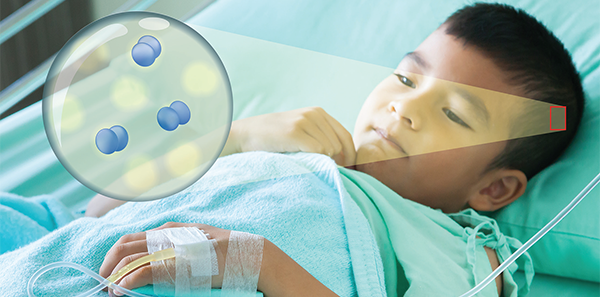
The best questions often stem from the inquisitive learner. As educators, we love—and are always humbled—by those moments when we get to say, “I don’t know.” For some of these questions, some may already know the answers. For others, some may never have thought to ask the question. For all, questions, comments, concerns, and critiques are encouraged. Welcome to the Kids Korner.
Explore This Issue
ACEP Now: Vol 35 – No 03 – March 2016Question 1: After administration of IV antibiotics for suspected meningitis in children, how long do you have before sterilizing the cerebrospinal fluid (CSF), yielding a negative CSF culture?
This question is dependent on the antibiotic used to treat a patient’s suspected meningitis. A retrospective pediatric study by Blazer et al found that after 44–68 hours of IV treatment for known meningitis, the CSF culture was negative in 66/68 (97.1 percent) on repeat lumbar puncture (LP).1 While the CSF culture was negative at the time of repeat LP, there was no significant difference between the cell counts and CSF differential when comparing the admission LP results with the repeat LP results 44–68 hours later. Of note, the drugs in this retrospective study were ampicillin, chloramphenicol, and penicillin. While these results do not specifically answer the above question, they do suggest that, even after 44–68 hours of antibiotics, the CSF cell count and differential will not significantly change.
A more recent retrospective study by Crosswell et al looked specifically at CSF sterilization time in pediatric cases of confirmed meningococcal meningitis after pretreatment with the third-generation cephalosporin cefotaxime.2 This study’s aim was to determine how long children needed continued antibiotic treatment and included 48 children ages 0–14 years. While not the aim of the paper, it did demonstrate that no patient receiving an LP more than five hours after antibiotic administration had a positive culture for Neisseria, suggesting that the CSF is sterilized by five hours.
Finally, Kanegaye et al performed a retrospective study of 128 pediatric meningitis patients ages 0–16 years.3 Meningitis was defined as: 1) a CSF culture positive for a known bacterial pathogen, 2) a positive CSF antigen study, 3) a CSF pleocytosis and positive gram stain, 4) a positive blood culture combined with CSF white blood cells (WBCs) greater than 100/mL, or 5) CSF WBCs greater than 4,000/mL alone. Ninety-two percent (82/89) of the CSF cultures were positive if the LP was performed prior to antibiotic administration. Only 56 percent (22/39) of CSF cultures were positive in the group that was pretreated with antibiotics before the LP, and in this pretreatment group, the LP was delayed up to 72 hours in some patients. The three most common meningitis pathogens were N. meningitidis, S. pneumoniae, and group B streptococcus (GBS). With the exception of N. meningitidis, CSF cultures for pneumococcus and GBS were not sterile (negative) until four hours of antibiotic pretreatment. Neisseria cases were all sterile beyond three hours following pretreatment. Ninety-eight percent of these patients were treated with a third-generation cephalosporin.
Summary
Sooner is better, but retrospective studies suggest that you probably have three to four hours after antibiotic administration before CSF sterilization in cases of S. pneumoniae and GBS. For potential N. meningitidis cases, though, you probably have a much smaller window of one to two hours before CSF sterilization.
While not the aim of the paper, it did demonstrate that no patient receiving an LP more than five hours after antibiotic administration had a positive culture for Neisseria, suggesting that the CSF is sterilized by five hours.
Question 2: After a palatal puncture wound by a sharp object, is computed tomography angiography (CTA) necessary to evaluate for a carotid injury in children?
Current literature includes retrospective and case studies. A retrospective study by Hennelly et al looked at 205 well-appearing children between ages 9 months and 18 years with a normal neurological exam.4 The primary goal of the study was to identify any stroke or infection. Exclusion criteria included operative intervention for a retained foreign body, persistent bleeding, expanding hematoma, or intubation. Secondary goals of the study looked at CTA use, any positive CTA findings (excluding air), and any intervention (anticoagulation, operative, and admission for observation). The lateral soft palate was involved in 71 percent of the cases, and infection developed in 3/205 (1.4 percent) cases. No patients developed stroke. Ninety (44 percent) of the patients got a CTA, and 10 percent (9/90) of these scans were interpreted as positive, with one intimal tear and eight cases of edema. None of the positive CTA results led to any significant interventions like surgical intervention or anticoagulation. The authors were unable to draw any definitive conclusions about antibiotic prophylaxis and its relationship to infection. Other retrospective studies by Hellmann et al (n=131) and Radkowski et al (n=23) found no neurologic complications as well.5,6
To be fair, there are rare case reports that talk about carotid injuries that manifest more than 24 hours after the injury. They are very rare but do exist.
Summary
The likelihood of a carotid injury following penetrating trauma to the soft palate is very low, suggesting that imaging may not be necessary in neurologically normal well-appearing children. However, there are no prospective studies on this topic.
 Dr. Jones is assistant professor of pediatric emergency medicine at the University of Kentucky in Lexington.
Dr. Jones is assistant professor of pediatric emergency medicine at the University of Kentucky in Lexington.
 Dr. Cantor is professor of emergency medicine and pediatrics, director of the pediatric emergency department, and medical director of the Central New York Poison Control Center at Upstate Medical University in Syracuse, New York.
Dr. Cantor is professor of emergency medicine and pediatrics, director of the pediatric emergency department, and medical director of the Central New York Poison Control Center at Upstate Medical University in Syracuse, New York.
References
- Blazer S, Berant M, Alon U. Effect of antibiotic treatment on cerebrospinal fluid. Am J Clin Pathol. 1983;80(3):386-387.
- Crosswell JM, Nicholson WR, Lennon DR. Rapid sterilisation of cerebrospinal fluid in meningococcal meningitis: implications for treatment duration. J Paediatr Child Health. 2006;42(4):170-173.
- Kanegaye JT, Soliemanzadeh P, Bradley JS. Lumbar puncture in pediatric bacterial meningitis: defining the time interval for recovery of cerebrospinal fluid pathogens after parenteral antibiotic pretreatment. Pediatrics. 2001;108(5):1169-1174.
- Hennelly K, Kimia A, Lee L, et al. Incidence of morbidity from penetrating palate trauma. Pediatrics. 2010;126(6):1578-1584.
- Hellmann JR, Shott SR, Gootee MJ. Impalement injuries of the palate in children: review of 131 cases. Int J Pediatr Otorhinolaryngol. 1993;26(2):157-163.
- Radkowski D, McGill TJ, Healy GB, et al. Penetrating trauma of the oropharynx in children. Laryngoscope. 1993;103(9):991-994.
Pages: 1 2 | Multi-Page

 ACEP Now features one article each issue related to an ACEP eCME CME activity.
ACEP Now features one article each issue related to an ACEP eCME CME activity.




No Responses to “Guidance on Cerebrospinal Fluid Sterilization in Pediatric Meningitis, Carotid Injury Risk after Palatal Wound in Children”